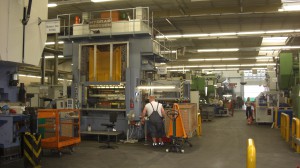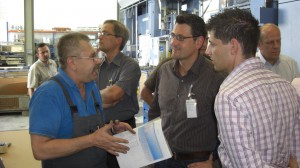From the beginning, Steel Automotive has valued the automation of production processes. The greater the level of automation, the greater the process security and the lower the costs, that is the maxim of the management.
 Since 2005, Steel Automotive has operated successfully as a result of the commitment of two companies, C. Rob Hammerstein GmbH & Co. KG and the Willi Elbe Group. Steel Automative produces stamped and formed parts for the car industry, for example carrier plates for motor control, parts for car electronics or the infotainment, elements for sunroofs, and much more. Customers include Bosch, Valeo, Continental, Visteon and Panasonic, to name just a few. These are well-known companies which attach much importance to high quality.
Since 2005, Steel Automotive has operated successfully as a result of the commitment of two companies, C. Rob Hammerstein GmbH & Co. KG and the Willi Elbe Group. Steel Automative produces stamped and formed parts for the car industry, for example carrier plates for motor control, parts for car electronics or the infotainment, elements for sunroofs, and much more. Customers include Bosch, Valeo, Continental, Visteon and Panasonic, to name just a few. These are well-known companies which attach much importance to high quality.
Taking greater personal respons-ibility for production
The ERP system infor.com, which has been implemented by the sales partner SGP, has already been in use for quite a long time. Only a constant flow of data to the machinery was lacking. SGP presented the Web-based software solution includis.mdc. This was popular and so it is that 17 machines, including three large presses, are controlled in a fully automated way by means of this solution, while eight more large presses and a robot are soon to be connected. A constant flow of information from office to machine ensures full process documentation. The recorded data are processed and are available as key performance indicators (KPIs) in real time via Web browser access on the intranet and on the internet. Infor.time BDE terminals for data input are connected directly with Includis by means of ERP integration. The General Manager, Mr Schumann, plans to buy two plasma screens to display the exact and current production figures in central locations in the production facilities. This, he believes, will help employees to control their own activities as well as to ensure a successful outcome. He would like to involve his 250 employees in the activities of the business to an even greater extent and to challenge them to take responsibility for their own performance.
Aims of the business management with regard to investment decisions
Problem-free installation, the rapid availability of meaningful machine data and value for money as well as simple intuitive operation were the aims which Mr Schumann was hoping to combine when he made his decision. To the question of what results the implementation of MDE connection had brought, Mr Schumann answered: “The evaluation of machine data by means of error and fault analysis has become an essential part of production.  These data are reliable, accurate and up to date. They are automatically recorded and cannot be manipulated. We can measure the overall time of a production process and then break it down afterwards. Reasons for faults can be allocated for every item; i.e. x reasons for faults could be defined for 400 tools. It is relatively easy to record the reasons for system faults. With the continuous monitoring of production, errors can be avoided and a good quality of production can be achieved. The system supports quality standard TS 16949. The Web database is also very good. During a stay in Milan, I was able to log on to my production via the internet and learn the current state of production.”
These data are reliable, accurate and up to date. They are automatically recorded and cannot be manipulated. We can measure the overall time of a production process and then break it down afterwards. Reasons for faults can be allocated for every item; i.e. x reasons for faults could be defined for 400 tools. It is relatively easy to record the reasons for system faults. With the continuous monitoring of production, errors can be avoided and a good quality of production can be achieved. The system supports quality standard TS 16949. The Web database is also very good. During a stay in Milan, I was able to log on to my production via the internet and learn the current state of production.”
Automated O.E.E. from the point of view of a works council
On a tour of the company, a group of interested people met the works council, who explained the benefits of automated O.E.E. calculation. The works council regards the main benefit as being an increase in production. It also confirmed that there was a high level of employee acceptance. Mr Schumann is of the opinion that, if an O.E.E. is less than 50%, this is a reason for increasing capacity and not for buying a new machine. An indicator which reads at least 70% is what is sought. It is checked whether the level of utilization of machinery can be increased by the reorganization of shifts in the production facilities. Runtime behaviour has been constantly recorded during the last three months. Specific measures can now be taken on the basis of these evaluations. To sum up, Mr Schumann has already assessed the value of machine data in the past and is now happy to have invested in a reliable MDE system in the new company. It only took a month for him to reach his decision. Now he cannot imagine not having the constant monitoring of production by machinery with automated e-mail or SMS reporting systems.